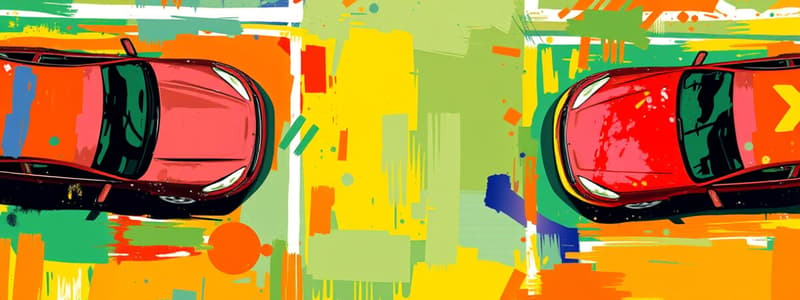Podcast
Questions and Answers
What does Hill Parking refer to?
What does Hill Parking refer to?
- Parking diagonally to a curb
- Parallel parking where the front wheels are turned to prevent the vehicle from rolling downhill (correct)
- Parking at a right angle to the curb
- Maneuver used to turn your vehicle around
What is Perpendicular Parking?
What is Perpendicular Parking?
- Parking at a right angle to the curb (correct)
- Parking that requires a large space
- Parking diagonally to a curb
- Parallel parking with wheels turned
What is a Turnabout?
What is a Turnabout?
A maneuver used to turn your vehicle around so you can go in the opposite direction.
What does a Convex Mirror do?
What does a Convex Mirror do?
What is Parallel Parking?
What is Parallel Parking?
What is a Forward Reference Point?
What is a Forward Reference Point?
What is Angle Parking?
What is Angle Parking?
Define a Reference Point.
Define a Reference Point.
What is a Standard Reference Point?
What is a Standard Reference Point?
What is a Personal Reference Point?
What is a Personal Reference Point?
What type of Turnabout requires a wide space?
What type of Turnabout requires a wide space?
Which turnabout is used when there is a driveway on the right and no traffic behind?
Which turnabout is used when there is a driveway on the right and no traffic behind?
Which turnabout requires you to back across two lanes of traffic?
Which turnabout requires you to back across two lanes of traffic?
What turnabout requires that you back into the traffic flow before moving forward?
What turnabout requires that you back into the traffic flow before moving forward?
Which turnabout requires that you stop your car across traffic lanes?
Which turnabout requires that you stop your car across traffic lanes?
What is an escape path?
What is an escape path?
Define ovsp.
Define ovsp.
What are zones?
What are zones?
What does 'path of travel' refer to?
What does 'path of travel' refer to?
What is an open zone?
What is an open zone?
Define a space cushion.
Define a space cushion.
What is a field of vision?
What is a field of vision?
What is a closed zone?
What is a closed zone?
Define compromise space.
Define compromise space.
What does it mean to minimize a hazard?
What does it mean to minimize a hazard?
What is traction?
What is traction?
What does selective seeing mean?
What does selective seeing mean?
What is a target area?
What is a target area?
What does the 12-15 second range refer to?
What does the 12-15 second range refer to?
What is peripheral vision?
What is peripheral vision?
Define the 4-6 second range.
Define the 4-6 second range.
What is scanning?
What is scanning?
What does it mean to separate hazards?
What does it mean to separate hazards?
What is central vision?
What is central vision?
What does line of sight mean?
What does line of sight mean?
What are high beams?
What are high beams?
What are low beams?
What are low beams?
What does overdriving headlights mean?
What does overdriving headlights mean?
Study Notes
Parking Techniques
- Hill Parking: Requires turning the front wheels to prevent rolling downhill when the vehicle is unattended.
- Perpendicular Parking: Involves parking at a right angle to the curb.
- Angle Parking: Parking diagonally to the curb to maximize space utilization.
- Parallel Parking: Needs a space approximately six feet longer than the vehicle.
Turning Maneuvers
- Turnabout: A maneuver to turn the vehicle around to face the opposite direction.
- Mid Block U-Turn: Requires a wide space, as no backing is involved.
- Back Into The Driveway On The Right Side: Used when a right-side driveway is available and there's no traffic behind.
- Three-Point Turnabout: Involves stopping the vehicle across traffic lanes to complete the turn.
Mirrors and Reference Points
- Convex Mirror: Provides a wider view of the vehicle's surroundings.
- Reference Point: A part of the vehicle linked to roadway elements from the driver’s perspective.
- Standard Reference Point: A common reference used by most drivers.
- Personal Reference Point: A unique marker for individual drivers.
Safety and Vision
- Escape Path: An area to maneuver in case of potential conflict.
- Field of Vision: The entire area visible to the driver while looking straight ahead.
- Closed Zone: A space limited due to restrictions impacting line of sight or path of travel.
- Open Zone: A space allowing freedom of movement without obstacles.
Hazard Management
- Space Cushion: The area around the vehicle that is free from hazards and conflicts.
- Minimize a Hazard: Involves increasing distance from potential risks to reduce danger.
- Separate Hazards: Adjusting speed to manage one hazard at a time rather than facing multiple simultaneously.
Vision Techniques
- Selective Seeing: Identifying only the relevant clues and hazards important for driving.
- Scanning: Conducting an orderly visual search pattern for effective observation.
- Peripheral Vision: The area surrounding central vision that provides additional awareness.
Driving Ranges and Techniques
- 12-15 Second Range: The ideal scanning range for noticing changes in your line of sight and path of travel.
- 4-6 Second Range: Provides the final update on your vehicle's intended path of travel.
- Overdriving Headlights: Occurs when driving too fast for visibility; remedy by reducing speed.
Headlight Usage
- High Beams: Designed for open country roads, shining up to 500 feet ahead.
- Low Beams: Typically used in darkness, illuminating up to 150 feet in front of the vehicle.
Studying That Suits You
Use AI to generate personalized quizzes and flashcards to suit your learning preferences.
Description
Test your knowledge on various parking techniques and turning maneuvers that are essential for safe driving. This quiz covers everything from hill parking to three-point turnabouts, including the use of mirrors and reference points. Challenge yourself to see how well you understand these critical driving skills!




